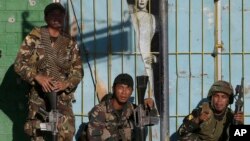The Philippine military says troops have rescued 116 hostages in the past 18 hours and recaptured 70 percent of the coastal area recently occupied by rebels in a continuing standoff between the army and Muslim rebels.
A military spokesman said on Tuesday that about 100 rebels with the Moro National Liberation Front, or MNLF, were still engaging in clashes with troops in the southern port city of Zamboanga. He said officials are uncertain how many more hostages the rebels are still holding, but some 64 hostages were freed during military operations on Tuesday.
A truce was supposed to have gone into effect on Saturday after a ceasefire agreement was reached on Friday by Philippine Vice President Jejomar Binay and MNLF faction leader Nur Misuari. However, fighting in the region has continued.
The standoff began last Monday when rebels stormed Zamboanga, taking scores of hostages whom officials say they have used as human shields.
Schools and most government offices in Zamboanga have been closed, and the government has continued to ground flights to and from the area. The fighting has displaced some 70,000 people and hundreds of homes have been set on fire.
The MNLF has long pushed for greater autonomy in the mainly Muslim south, where a four-decade-long insurgency has killed at least 120,000 people.
The group signed a peace agreement with the government in 1996 that led to the creation of the Autonomous Region in Muslim Mindanao, but some of its members continued to fight, claiming that Manila did not hold up its end of the deal to develop the impoverished, rural region.
Recently, MNLF founder Misuari has criticized the government's peace talks with a larger Muslim rebel group, the Moro Islamic Liberation Front. Fearing the negotiations may marginalize his own group's power, Misuari last month declared part of the country's south to be independent of the government.
Under Misuari's leadership, the MNLF carried out an attack in Zamboanga in 2001 that was similar to this most recent one. At the conclusion of that attack, the fighters were allowed to leave after releasing their hostages.
A military spokesman said on Tuesday that about 100 rebels with the Moro National Liberation Front, or MNLF, were still engaging in clashes with troops in the southern port city of Zamboanga. He said officials are uncertain how many more hostages the rebels are still holding, but some 64 hostages were freed during military operations on Tuesday.
A truce was supposed to have gone into effect on Saturday after a ceasefire agreement was reached on Friday by Philippine Vice President Jejomar Binay and MNLF faction leader Nur Misuari. However, fighting in the region has continued.
The standoff began last Monday when rebels stormed Zamboanga, taking scores of hostages whom officials say they have used as human shields.
Schools and most government offices in Zamboanga have been closed, and the government has continued to ground flights to and from the area. The fighting has displaced some 70,000 people and hundreds of homes have been set on fire.
The MNLF has long pushed for greater autonomy in the mainly Muslim south, where a four-decade-long insurgency has killed at least 120,000 people.
The group signed a peace agreement with the government in 1996 that led to the creation of the Autonomous Region in Muslim Mindanao, but some of its members continued to fight, claiming that Manila did not hold up its end of the deal to develop the impoverished, rural region.
Recently, MNLF founder Misuari has criticized the government's peace talks with a larger Muslim rebel group, the Moro Islamic Liberation Front. Fearing the negotiations may marginalize his own group's power, Misuari last month declared part of the country's south to be independent of the government.
Under Misuari's leadership, the MNLF carried out an attack in Zamboanga in 2001 that was similar to this most recent one. At the conclusion of that attack, the fighters were allowed to leave after releasing their hostages.









